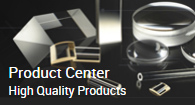What else do you not know about the classification of right angle prism materials?
Right Angle prism is a transparent material made of polyhedron,according to the different orientation of the prism,the imaging can be left and right consistent and upside down and left and right consistent,the use of the range is also very wide,right Angle prism can also be used in image combination,beam deviation and other applications.
When the right Angle prism is used,some optical film is usually plated.The right Angle prism itself has a large contact area and a typical Angle of 45° and 90°,so compared with ordinary mirrors,the right Angle prism is easier to install and has better stability and strength against mechanical stress.They are the best choice of optical components for all kinds of devices and instruments.
According to the main characteristics,the right Angle prisms can be divided into UV fused quartz right Angle prisms,H-K9L right Angle prisms,calcium fluoride right Angle prisms,zinc selenide right Angle prisms, right Angle prisms of different materials.
UV fused quartz right angle prism
Uncoated (185 nm-2.1 m),if higher ultraviolet transmittance or lower coefficient of thermal expansion is required,UV fused quartz right Angle prisms can be selected.Ultraviolet-grade fused quartz has high transmittance in the deep ultraviolet and almost no laser-induced fluorescence is measured at 193 nm,so it is ideal for ultraviolet to near-infrared applications.For a given wavelength,UV fused quartz has a smaller refractive index than H-K9L.
H-K9L right angle prism
Uncoated (350 nm-2 m),if you do not need the additional advantages of molten quartz,you can choose the H-K9L right Angle prism.H-K9L has excellent transmittance in the visible and near infrared parts of the spectrum.In addition,H-K9L is the best choice for ultraviolet applications with wavelengths as low as 350 nm,where the highest transmission rate is required,the right Angle prism can be coated with an anti-reflection film.
Calcium fluoride right angle prism
Uncoated (180 nm-8 m),calcium fluoride right Angle prisms can be selected for applications requiring high transmittance in the wavelength range from 180 nm to 8 m.Calcium fluoride materials have a low refractive index,ranging from 1.35 to 1.51 in the wavelength range of 180 nm to 8 m,and also have an extremely high laser damage threshold.Calcium fluoride is also quite chemically inert and has a superior hardness compared to fluorides such as barium fluoride,magnesium fluoride and lithium fluoride.
Zinc selenide right angle prism
Uncoated (600 nm-16 m),zinc selenide is an ideal optical material for use in the 600 nm to 16 m range,which is characterized by low absorptance,including the red band of visible light,and good shock resistance.Zinc selenide is ideal for use in carbon dioxide lasers operating at 10.6 m,including those using helium-neon laser alignment.Gloves should be worn when handling optical components.This is especially important when using zinc selenide,which is toxic,and for your safety,follow all specific defensive measures,including wearing gloves when handling prisms and washing your hands thoroughly after use.Because of the low hardness of zinc selenide,careful handling is required to avoid damaging these prisms.
right angle prism
Uncoated (2-16 µm), is suitable for infrared applications due to its wide transmittance range (2-16 µm) and opacity in the visible spectrum.This material is inert to air,water, alkali and acid (except nitric acid).The transmittance of is greatly affected by temperature. is almost opaque at 100°C and completely opaque at 200°C.
Wear gloves when you take optical components.This is especially important when you are working with ,which is toxic.For your safety, follow all reasonable defensive measures,such as wearing gloves when handling the prism and washing your hands completely after use.
According to the above, have you learned?
If you are interested in this, please contact us.Click here to view parameters and other information.

